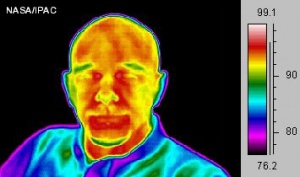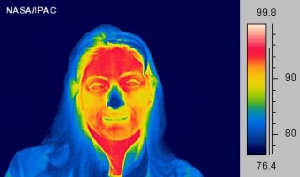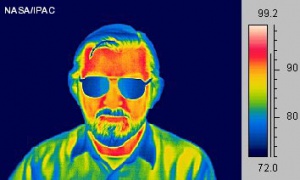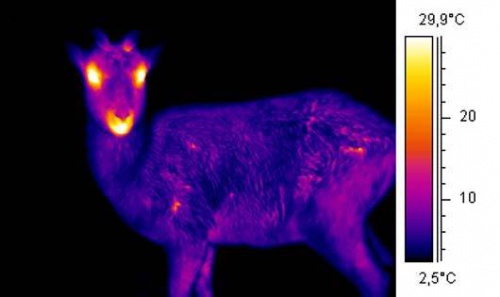Difference between revisions of "Calorimetry Lab"
| Line 37: | Line 37: | ||
:4) HCl (aq) + NaOH (aq) --> H<sub>2</sub>O (l) + NaCl (aq) | :4) HCl (aq) + NaOH (aq) --> H<sub>2</sub>O (l) + NaCl (aq) | ||
::This is a acid-base neutralization reaction. | ::This is a acid-base neutralization reaction. | ||
| − | :5) Na(s) + | + | :5) Na(s) + H<sub>2</sub>O (l) --> NaOH (aq) + H<sub>2</sub> (g) |
[https://youtu.be/VSyEWg10WjM Envisioning Chemistry: Getting Hot (with Thermal Imaging)] | [https://youtu.be/VSyEWg10WjM Envisioning Chemistry: Getting Hot (with Thermal Imaging)] | ||
Revision as of 17:16, 6 April 2020
Welcome to the Calorimetry Gen Chem Lab...sort of...
As was discussed in lecture this morning, the current chapter is titled thermochemistry...the heat associated with a chemical reaction. You now have a clear understanding of a chemical reactions...there are reactants, products, balancing coefficients, and now there is heat. Let's start our conversation with a simple observation.
Thermal Imaging
 |
 |

|
All living organisms have many chemical reactions going on 24/7. Most of these reactions are exothermic, meaning that these reactions give off heat. So you should not be surprised to see that a person, like the man on the left is radiating heat. As you know, humans are warm blooded organisms that maintain their body temperature at 37 oC or 98.6 oF. The above images use infrared (IR) imaging to detect the heat (IR light) emitting from all warm blooded organisms. We will talk more about IR light in our next chapter.
The man on the left has a skin temperature of ~93 oF (yellow/orange). The inside corners of his eyes and his lips are slightly higher in temperature at ~95 oF (red). since the outside/room temperature is usually less than body temperature, the surface of the skin is slightly cooler than the internal core temperature of 98.6 oF. This is why when we measure the temperature of an individual, it is best to put a thermometer under your tongue or in up the ... (you know). There are devices that are calibrated to measure internal temperature by measuring outside skin temperature, but these are not as reliable as doing an "under tongue" measurement.
The woman above and in the middle has an IR image that i slightly different from the man.
- Q: What differences do you see? (write these down in your notes...then move on).
The first thing i noticed with the IR image of the woman is that her neck and forehead were warmer than the man, also her nose is quite cold. It could be the case that she just came in from the cold outside; she might have worn a scarf with her nose unprotected from the cold. Additional , she might have a fever. Additionally, notice how her hair and clothing are much cooler, much closer to room temperature.
The man on the right has glasses and a beard that maintain a temperature cooler than the body temp or closer to room temp. Hair in general insulates the body from heat loss.
I could share all kinds of stories about IR imaging. Our department has multiple iphone/android IR camera that we use in Chem 312 (Thermodynamics). But i will stop after these two images:
 |

|
The thermal image of the deer (left) shows how well its fur insulates it from the cold. The thermal image on the right shows how this type of imaging can be used to identify hidden items under clothing.
Here is a fun article about thermal imaging of animals (optional): Hot and Wild 14 Thermal Images of Animals
Chemical reactions
In the following (awesome) video, you will see the thermal imaging of 5 chemical reactions:
- 1) NaOH (s) --> NaOH (aq)
- Dissolving a piece of solid sodium hydroxide into water. This process/reaction with water is called dissolution or just dissolving.
- 2) H2SO4 (l) --> H2SO4 (aq)
- Concentrated sulfuric acid is ~98% pure. This process/reaction with water is also a dissolution or dissolving sulfuric acid into water.
- 3) H2SO4 (l) + cellulose --> carbon (s) + H2O (l) and more.
- In this reaction H2SO4 (l) is reacting with cellulose (carbon/hydrogen, ie sugars); this results in the dehydration (loss of water) of cellulose.
- 4) HCl (aq) + NaOH (aq) --> H2O (l) + NaCl (aq)
- This is a acid-base neutralization reaction.
- 5) Na(s) + H2O (l) --> NaOH (aq) + H2 (g)